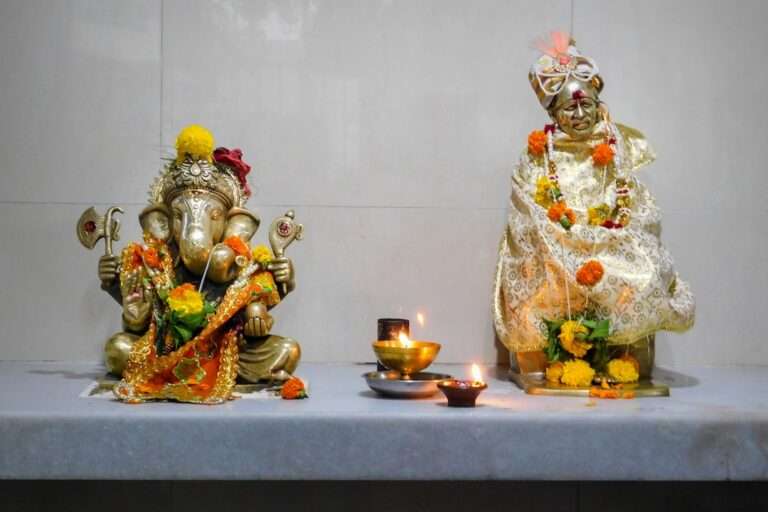Exploring Cultural Color Symbolism

Color symbolism is the use of color to represent ideas, emotions, and cultural values. It plays a significant role in cultural understanding as it helps to convey meaning and communicate messages in various societies around the world. Different colors hold different meanings and associations in different cultures, and understanding these symbols is crucial for effective communication and cultural appreciation.
The Significance of Color in Cultural Symbolism
Color symbolism refers to the use of color to represent abstract concepts or ideas. It is a powerful tool for expressing cultural identity and values, as well as conveying emotions and messages. Colors can evoke certain feelings or emotions, and they can also carry cultural significance that may not be immediately apparent to outsiders.
In many cultures, certain colors are associated with specific meanings. For example, in Western cultures, red is often associated with love and passion, while white is associated with purity and innocence. In Eastern cultures, red is often associated with luck and prosperity, while yellow is associated with royalty and power. These associations are deeply ingrained in the cultural fabric of these societies and are often used in various aspects of life, such as clothing, art, and religious rituals.
The Influence of Geographical Location on Color Symbolism
Geographical location plays a significant role in color symbolism as it can influence the way colors are perceived and understood. Different regions have different natural landscapes, climates, and cultural histories, which can shape the meanings associated with certain colors.
For example, in Western cultures, blue is often associated with calmness and tranquility because of its association with the sky and the ocean. In contrast, in some Eastern cultures, blue can be associated with sadness or mourning because it is the color of death. This difference in interpretation is influenced by the geographical location and cultural history of these regions.
Similarly, the color green can have different meanings depending on the geographical location. In Western cultures, green is often associated with nature and growth, while in some Eastern cultures, green can be associated with jealousy or envy. This difference in interpretation is influenced by the different natural landscapes and cultural contexts of these regions.
Color Symbolism in Eastern Cultures
In Eastern cultures, color symbolism holds great importance and is deeply ingrained in various aspects of life. For example, in China, the color red is associated with luck and prosperity. It is often used during festive occasions such as Chinese New Year and weddings to bring good fortune. In Japan, the color red is associated with life force and vitality and is often used in traditional clothing such as kimonos.
In India, the color yellow is associated with purity and spirituality. It is often used in religious ceremonies and is considered sacred. In Thailand, the color yellow is associated with the monarchy and is worn on Mondays to show respect for the king.
These examples demonstrate how color symbolism varies across different Eastern cultures and how it is deeply rooted in their traditions, beliefs, and values.
Color Symbolism in Western Cultures
In Western cultures, color symbolism also plays a significant role in various aspects of life. For example, in Western weddings, the color white is often associated with purity and innocence. The bride traditionally wears a white wedding dress to symbolize her purity and virginity.
In Western art, colors are often used to convey emotions and moods. For example, warm colors such as red and orange are often used to depict passion or anger, while cool colors such as blue and green are used to depict calmness or tranquility.
In Western advertising, colors are used strategically to evoke certain emotions or associations. For example, fast-food chains often use red and yellow in their logos and branding to stimulate appetite and create a sense of urgency.
These examples illustrate how color symbolism is deeply embedded in Western cultures and how it is used to convey meaning and evoke emotions.
The Role of Color in Religious Symbolism

Color plays a significant role in religious symbolism across different cultures and religions. Different colors are often associated with specific religious beliefs, rituals, and deities.
For example, in Christianity, the color purple is associated with royalty and is often used during the season of Lent to symbolize penance and preparation for Easter. In Hinduism, the color saffron is considered sacred and is often associated with fire and purity. It is used in religious ceremonies and is worn by monks and spiritual leaders.
In Buddhism, the color gold is associated with enlightenment and spiritual awakening. It is often used in Buddhist temples and statues to represent the divine nature of the Buddha.
These examples demonstrate how color symbolism is used in religious contexts to convey spiritual meanings and create a sense of reverence and awe.
The Meaning of Color in Traditional Clothing
Color symbolism is also evident in traditional clothing across different cultures. Colors are often used to convey social status, cultural identity, and traditional values.
For example, in many African cultures, the color red is associated with vitality and power. It is often used in traditional clothing to symbolize strength and courage. In some Native American cultures, the color turquoise is considered sacred and is often used in jewelry and clothing to represent protection and healing.
In traditional Chinese culture, the color red is considered auspicious and is often used in traditional clothing such as cheongsams or qipaos. It symbolizes luck, happiness, and prosperity.
These examples highlight how color symbolism is used in traditional clothing to express cultural identity, values, and beliefs.
Color Symbolism in Art and Design
Color symbolism plays a crucial role in art and design as it can evoke emotions, create visual impact, and convey meaning. Artists and designers use colors strategically to communicate their ideas and messages.
For example, in impressionist paintings, artists often use vibrant colors such as blues, greens, and yellows to depict the play of light and create a sense of movement and energy. In abstract art, colors are often used to convey emotions and moods. For example, warm colors such as red and orange can evoke feelings of passion or excitement, while cool colors such as blue and green can evoke feelings of calmness or tranquility.
In graphic design, colors are used to create visual impact and communicate messages. For example, the use of bold, contrasting colors can grab attention and create a sense of urgency, while the use of soft, muted colors can create a sense of calmness and elegance.
These examples demonstrate how color symbolism is used in art and design to create visual impact, evoke emotions, and convey meaning.
The Evolution of Color Symbolism over Time
Color symbolism has evolved over time as societies and cultures have changed and developed. The meanings associated with certain colors have shifted or expanded, reflecting the changing values and beliefs of different cultures.
For example, in Western cultures, the color purple was historically associated with royalty and wealth because it was a rare and expensive dye to produce. However, over time, the meaning of purple has expanded to include notions of spirituality, creativity, and individuality.
Similarly, in some Eastern cultures, the color white was traditionally associated with death and mourning. However, with the influence of Western cultures, white has also come to symbolize purity and innocence.
These examples illustrate how color symbolism is not static but rather evolves over time as cultures interact and influence one another.
Color Symbolism in Contemporary Culture
Color symbolism continues to play a significant role in contemporary culture. Colors are used strategically in branding, advertising, fashion, and interior design to convey messages and create associations.
For example, in branding and advertising, companies often use specific colors to evoke certain emotions or associations. Fast-food chains often use red and yellow to stimulate appetite and create a sense of urgency, while luxury brands often use black and gold to convey elegance and sophistication.
In fashion, colors are used to create trends and express individuality. Certain colors may become popular in a particular season or year, reflecting the current cultural mood or aesthetic preferences.
In interior design, colors are used to create specific atmospheres and moods. Warm colors such as red and orange can create a cozy and inviting space, while cool colors such as blue and green can create a calm and serene environment.
These examples demonstrate how color symbolism continues to be relevant and influential in contemporary culture.
The Importance of Understanding Color Symbolism in a Globalized World
Understanding color symbolism is crucial in a globalized world where cultures are increasingly interconnected. Misunderstandings or misinterpretations of color symbolism can lead to cultural misunderstandings or even offense.
For example, the color white is often associated with purity and innocence in Western cultures. However, in some Eastern cultures, white is associated with death and mourning. If someone from a Western culture were to wear white to a funeral in an Eastern culture, it could be seen as disrespectful or insensitive.
Similarly, the color red is associated with luck and prosperity in many Eastern cultures. However, in some Western cultures, red is associated with danger or warning. If a company were to use red packaging for a product in a Western market, it could create negative associations and affect consumer perception.
These examples highlight the importance of understanding color symbolism in order to navigate cultural differences and avoid misunderstandings.
Color symbolism is a powerful tool for communication and cultural understanding. It plays a significant role in expressing cultural identity, conveying emotions, and conveying messages. Understanding color symbolism is crucial in a globalized world where cultures are increasingly interconnected. By learning about the meanings associated with different colors in different cultures, we can foster greater appreciation and respect for diverse perspectives and traditions. So let us take the time to explore and learn about color symbolism in different cultures, and embrace the richness and diversity it brings to our global community.
If you’re fascinated by the cultural significance of color, you’ll definitely want to check out this insightful article on Cultural Color Symbolism Around the World. It explores how different cultures assign meaning to colors and how these interpretations can vary widely. From the vibrant reds of China symbolizing luck and prosperity to the calming blues of India representing spirituality, this article delves into the rich tapestry of color symbolism across various societies. For more intriguing articles on symbolism, be sure to visit Symbolism Hub.
FAQs
What is cultural color symbolism?
Cultural color symbolism refers to the meanings and associations that different colors hold in various cultures around the world.
How do different cultures perceive colors?
Different cultures perceive colors differently. For example, in Western cultures, white is often associated with purity and weddings, while in some Asian cultures, white is associated with death and mourning.
What are some common color associations in different cultures?
Some common color associations in different cultures include red symbolizing luck and happiness in China, yellow representing royalty in Thailand, and blue representing trust and security in the United States.
How do cultural color associations impact marketing and advertising?
Cultural color associations can impact marketing and advertising by influencing how products and brands are perceived in different cultures. For example, a brand that uses red packaging in China may be perceived as lucky and successful, while the same brand using red packaging in the United States may be perceived as aggressive or dangerous.
Are there any universal color associations?
While there are some universal color associations, such as red being associated with danger and green being associated with nature, many color associations are specific to certain cultures and can vary widely.





